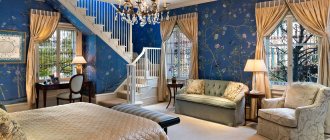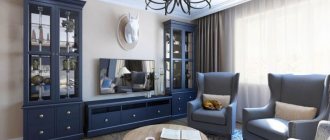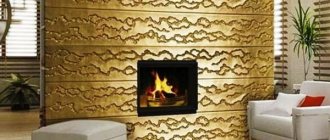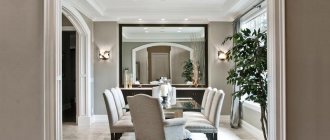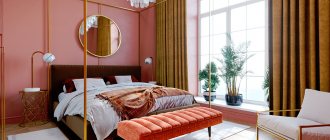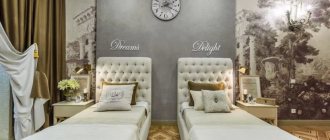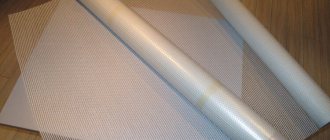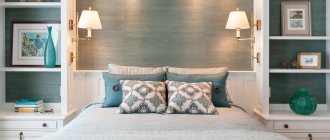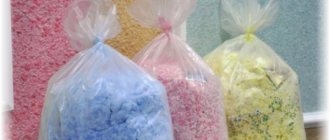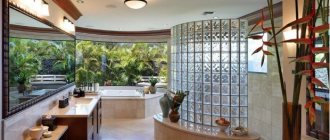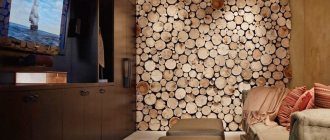Interior decoration of walls with natural materials was known back in the Ancient East, where the palaces of rulers were decorated in this way. Know how natural fabrics It was strictly kept by the masters and passed down from father to son. Today, natural wallpaper is especially relevant when creating luxurious interiors that fill the home with the harmony of nature itself, comfort and help maintain peace of mind.
Wallpaper from nature itself
Natural wallpapers have become especially popular recently among people who are trying to make their interior as natural as possible and do not want to use synthetic materials. Such wallpaper or flooring slabs have a number of advantages:
- they are absolutely environmentally friendly;
- natural materials have better sound and heat insulation than their synthetic counterparts;
- do not interfere with natural air circulation in the room;
- regulate the level of humidity in the room naturally;
- mostly hypoallergenic and have bactericidal properties;
- a huge selection of natural textures and colors provides unlimited possibilities for design ideas;
- Some types of natural wallpaper, such as bamboo, have a very long service life.
In fact, wallpaper made from natural materials consists of a base, which can be unbleached paper, canvas made from natural fabrics or non-woven fabric. On top of the base, threads from natural plants interwoven into patterns are attached: reed, arrowroot, Chinese nettle, leaves of various trees, bamboo, thin veneer of valuable tree species, papyrus, sisal .
It should be noted that the vast majority of organic natural wallpapers are produced using manual labor. This not only gives them uniqueness and sophistication, but also puts them among the most expensive finishing materials.
Wallpaper made of natural stone
People who want to create an antique atmosphere in their home will be delighted with the following proposal. Wallpaper made from natural stone
, will help turn all your ideas into reality. They are not only incredibly beautiful, but also durable. Experts highlight the following advantages of this decor:
- They do not absorb moisture, so mold cannot form on them.
- Wallpaper made of natural stone is not afraid of high temperatures.
- They perfectly retain heat in the room.
Installing such cladding is very easy. Its installation is very reminiscent of working with stone tiles. Therefore, you do not need to have special skills to glue such decor.
Natural veneer wallpaper
Designers who value uniqueness and originality choose the following facing materials. Natural veneer wallpaper
- this is an excellent solution for those who want to make their home truly special. The advantages of this material include:
- The ability of walls to “breathe”.
- Excellent sound insulation properties.
- Uniform distribution of moisture, which allows the wallpaper to dry faster.
Wallpaper made from durable natural veneer does not require special care. They practically do not fade over time. Unusual veneer patterns will create natural beauty and an exotic atmosphere in your home.
Types of natural wallpapers and their main characteristics
There is a large number of natural wallpapers, which are distinguished by manufacturing technology and materials used. The most common types are:
- made of natural wood;
- with a plant base;
- with bamboo inclusions;
- cork (made from natural cork);
- with leaves.
Wallpaper made of natural wood
Paper is used as the basis for such wallpaper. The top layer is made from thin sections of various tree species. The cut itself is so thin that it is practically indistinguishable from ordinary paper.
Wallpaper made from mahogany, rosewood, teak and other exotic species are considered especially popular.
They create a healthy microclimate in the room, are durable and easy to maintain. Due to the variety of textures, they are suitable for decorating living rooms, bedrooms and even children's rooms.
Plant based wallpaper
This type of wallpaper is made from sisal or jute. Paper or non-woven fabric is used as a backing. Strict geometric patterns or chaotic patterns are created from plant fibers, depending on the manufacturer. Regardless of the ornament, the outer surface of such wallpaper looks very original and aesthetically pleasing.
As a rule, this wallpaper is used to paste over walls or make fragmentary panels; it is also used for pasting ceilings and niches. They go well with simple paper wallpaper or sections of walls painted in natural colors. Most often used to decorate bedrooms or living rooms. The only drawback is that such wallpaper absorbs odors very quickly and is not recommended for kitchen decor.
Wallpaper with bamboo
Bamboo wallpaper is made from thin sections of bamboo, pressed at a certain temperature. They are baseless, uniform and practical. When making wallpaper from bamboo, dyes are almost never used, since their natural color spectrum is quite wide: from white-greenish to yellow-brown.
Sometimes some manufacturers coat the outer layer with a protective clear varnish.
This type of wallpaper is considered the most popular and versatile. They are perfect for finishing any room, including the kitchen and bathroom, they are easy to clean and are not afraid of wet cleaning.
Cork wallpaper
This type of natural wallpaper is obtained thanks to particles of cork tree bark pressed using a special technology. They are durable and practical, regulate the humidity in the room, condensation does not settle on their surface, and are resistant to sudden temperature changes.
Their most unusual and paradoxical property is that they do not support combustion and can even prevent the spread of fire.
In addition, cork wallpaper is considered an excellent sound insulator, and it retains heat well. For such a wide range of advantages, they are popular with many people. They decorate any room, including the bathroom and kitchen.
Foliage wallpaper
This type of finishing materials appeared relatively recently. The basis of leaf wallpaper is thin paper, onto which real fallen or dried leaves, pre-treated with high-temperature steam, are glued.
The main disadvantage of this type of wallpaper is its fragility and fragility. With the slightest force applied, the top decorative layer crumbles. Due to their low wear resistance, they are used to create decorative panels and small inserts on the wall or ceiling. For obvious reasons, they are not used in the kitchen or bathroom.
Features of gluing natural wallpaper
Due to the fact that each type of wallpaper is made of different materials and has a variation in weight, size and base options, gluing natural wallpaper occurs in different ways. There is a separate article on our website for each type of wallpaper, so you can familiarize yourself with the nuances of installation. Here we will collect only some recommendations that it is advisable to take into account during the gluing process.
- The surface must be well cleaned of the previous coating and leveled. Do not believe the myths that thick wallpaper will cover small uneven walls. For a perfect result you need perfect walls.
- Natural plant wallpaper should be kept indoors for several days so that it adapts to the environment. If possible, it is better to deploy them. At the same time, you should avoid an “unnatural” habitat for them, for example, if the room is temporarily very humid or hot.
- The glue you need to choose is the one recommended by the manufacturer. For example, the same textile wallpaper may have a paper or non-woven base, therefore, they will need different glue. Bamboo sticks well to liquid nails, and stone wallpaper sticks well to tile adhesive.
- Most often they are glued end to end. But sometimes there is a need to overlap. Then, after drying, the overlap is cut with a sharp knife from top to bottom, and the trimmings are removed.
- Do not allow the adhesive composition to come into contact with the front part, especially for textile wallpaper.
Natural wallpaper in a photo niche
In conclusion, it should be said that natural wallpaper is a wonderful choice for everyone who not only follows the latest trends in modern fashion, but prefers to look into the future. Let's hope that the hour will not be long before people give up synthetic food, clothing and building materials and give preference to everything natural.
Author of the article Alexander Kulikov
Using natural wallpaper in the interior: pros and cons
Natural wallpaper in the interior is used to create unique designs in various rooms. The most common room styles are country, modern, classic and ethno (especially Japanese style). Natural wallpaper can be used to cover walls, ceilings and even furniture . An interior with organic wallpaper looks very elegant and sophisticated.
In addition to the positive aspects, wallpaper made from natural materials has a number of negative properties:
- they are very expensive;
- not all professionals undertake to work with them;
- some types of wallpaper take a very long time to install and cut in a specific way, increasing the repair time several times;
- most wallpapers made from natural materials have a dark color scheme (the only exception may be some light wallpapers made from bamboo), which limits their use in small rooms or initially not very bright rooms;
- Due to their natural structure, they attract excessive attention from pets, who can easily tear them off with their claws.
Before using natural wallpaper, you should carefully weigh all its advantages and disadvantages.
Flower symbolism
When choosing a design, designers often focus on the age of the owner of the room:
- Slightly faded roses in discreet shades are an attribute of a woman’s bedroom, whose age cannot be attributed to either youth or old age.
- Succulent orchids - for a young woman.
- Falling peonies or tulips are a symbol of quickly passing years.
- In a children's bedroom, the floral theme can be revealed in the form of schematic or “cartoon” images in emotional colors.
- For teenagers, wallpaper with large flowers in their personal space is suitable; it is better to choose lush petals on a neutral background.
Stylish combination of floral wallpaper print with children's bed design
The color of the wallpaper depends on the style direction and the availability of free space in the room
Designers advise those who support innovative solutions to buy photo wallpapers with fairly realistic buds in an unusually large format or in 3D. A lotus, rose or orchid on a black background looks extravagant - the subconscious self-expression of young, purposeful women.
See alsoCombination of gray wallpaper in the interior photo
Installation of natural wallpaper: some subtleties
Due to the complexity and whimsical nature of the material, professionals categorically do not recommend gluing natural wallpaper yourself without special skills.
But, if you still decide to make an exclusive interior with your own hands, here are some tips from professionals:
- use only special glue;
- Before gluing, unroll the roll and leave the wallpaper to straighten naturally for at least a day;
- carefully prepare the surface of the walls or ceiling, first “stretching” it with putty, and then prime it;
- glue only at the joint;
- Remove excess glue immediately with a dry sponge.
The third group of wallpapers with floral patterns is monochrome
The pattern can be either monochromatic, contrasting, or soft, non-contrasting.
Contrasting monochrome wallpapers, like bright ones, should not be used on all walls of the room. Combine them with plain wall decoration.
Low-contrast wallpaper can be used to cover the entire room. An interior with monochrome wallpaper is based on a play of shades and a soft combination of non-contrasting colors. The result is a calm and cozy room.
Wallpaper with a floral pattern can become the highlight of the interior and give the room a stunning atmosphere. But what kind of atmosphere it will be, the choice is yours.
- Author: Natalya Zyryanova
Rate this article:
- 5
- 4
- 3
- 2
- 1
(12 votes, average: 4.7 out of 5)
Share with your friends!
How to glue natural wallpaper cosca
If you purchased cosca wallpaper, then the glue should preferably be of the same brand. Then the guarantee of good grip and excellent results will be in your pocket. Do the same when choosing other branded wallpapers, for example, Marseille.
Natural cosca wallpaper is environmentally friendly and easy to use. Native natural textures allow the flight of fancy without burdening you with technical difficulties in gluing
Tips for hanging cosca wallpaper:
- Print out the rolls and let them rest for a day;
- Inspect the wallpaper for defects - if you find it after cutting, you will not be able to return the product;
- The surface of the walls must be smooth, dry and clean;
- Cut the strips according to the height of the room + 10 cm;
- Quickly pour the glue into cold water and stir with vigorous movements;
- For 2 liters of water there is a two hundred gram pack of glue;
- The glue is applied with a roller to the inside of the roll;
- Glue should not get on the seams or the front part of the wallpaper;
- If the wallpaper is heavy, glue is also applied to the surface to be pasted;
- If glue is applied to the wall, the strip needs to be glued after a couple of minutes;
- The wallpaper from the window is glued, the first strip should be fixed exclusively vertically; for this, a level or plumb line is already taken.
In all other respects, natural wallpaper is glued in the same way as other types.
Natural wallpaper cosca in the interior (video)
Advantages of wallpaper made from natural materials
Natural wallpaper is a very interesting finishing material that has many advantages:
- resistance to harmful insects, as well as to the appearance and subsequent proliferation of various pathogens;
- ease of use;
- increased wear resistance;
- increased resistance to moisture;
- good sound insulation;
- structure, pleasant to the touch;
- environmental cleanliness.
